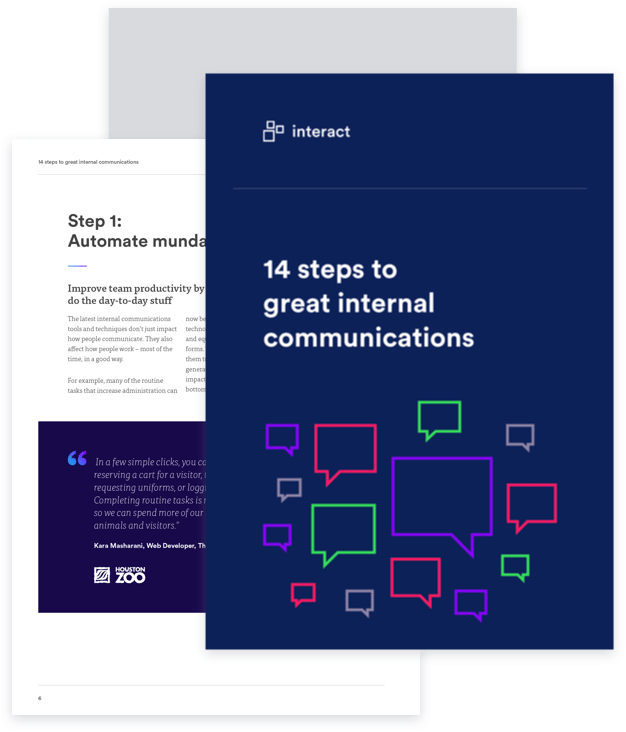Feedback is a critical component of business success and employee engagement. But if we opt to remove the names giving that feedback, does it trigger more honesty – or serve up further problems for managers?
Getting feedback from all areas of your organization is fundamental in today’s workplaces.
Capturing feedback enables us to understand what our employees want and need. It can throw up red flags before they develop into more serious problems and provides much-needed insight into what’s happening at grassroots level.
It isn’t only for the benefit of employees, however. In a culture where staff can speak freely about the issues they care about, or simply vocalize when things aren’t right, organizations will see higher levels of motivation, engagement, innovation, growth: and more. Put simply, feedback may be the allusive silver bullet with the power to impact many of your business KPIs.
Feedback takes many forms: whether it’s an informal chat between manager and employee or the formal annual employee satisfaction survey. However, giving staff a platform and voice comes with its own challenges. How often should you request feedback? Who should you ask? Who should do the asking? What do you do with the responses?
Perhaps one of the biggest and most contentious questions, however, is that of anonymity.
Going under the radar
The case for going anonymous is strong. There are many mental blocks for employees when it comes to speaking out; particularly when what they need to say isn’t necessarily positive.

While the possibility of getting fired because of the feedback we give is next to null, an innate sense of self-preservation prevents us from saying things that could be perceived as wrong to someone in authority. We may fear judgment, or lack confidence in our own assessments. By nature, most people hold back.
With the protection of anonymity, then, managers can gain more honest information and insights from employees. With the freedom to express themselves, staff can put forward valuable insights and shed light on issues that may otherwise be unsaid or not noticed higher up. Often, putting in place anonymous feedback channels means important issues are brought forward quicker: and can be addressed before they become a greater source of unhappiness or conflict.
Protecting anonymity can address the pandemic of ‘wilful blindness’ that personifies many of our workplaces: where there is information we can, should, or do know, but choose not to.
Anonymity also levels the playing field. Those who are naturally less willing to speak out are more likely to engage, making the process more inclusive. With higher levels of participation, it’s easier to identify common trends or widespread issues.
With no identifying information, managers also remove potential for prejudice or bias: a risk when the opinions of participants with more seniority, length of service, or experience may otherwise be afforded more gravitas. Even in the most inclusive of workplaces, there are subtle power structures that can make it difficult to gather and implement suggestions; anonymity removes this barrier.
The argument against anonymity
Despite the potential gains, many managers shy away from the idea of removing names against feedback.
By discouraging transparency, there’s an argument that we can’t spark true, two-way communication. If we don’t understand where specific issues have come from, we’re not able to address them directly: the result can become a cloak-and-dagger hunt for the source or underlying distrust or suspicion around ‘whodunnit.’
Anonymity grants people freedom to speak their minds. However, there’s a danger it will escalate into something we see on the internet regularly: mean spiritedness.

Behind the safety of a keyboard, there’s a risk that employees will use it as an opportunity to gripe, complain, or vent. While valid negative feedback is an important part of the process, overly critical comments – particularly when offered without any solution or workaround – aren’t productive.
In fact, the lack of accountability offered by anonymous feedback can actually lead to less accurate feedback, according to research. Without the need or motivation to answer “thoughtfully and precisely,” accuracy is reduced – and “socially undesirable attitudes” also increase.
Removing identifying factors can also make it more difficult to pinpoint issues. If, for example, there’s an issue or concern impacting a particular department, office, or location, but these attributes have been stripped from feedback, it becomes near-impossible to pinpoint. It makes no sense to address a critique that doesn’t apply to an entire group: leaving management in a troubling situation.

We also have to ask ourselves whether anonymous feedback will, in fact, be truly anonymous. It’s the first doubt every member of staff will cast as they speculate about who’s reading the data and whether they’ll be able to tell who has written specific comments. The act of making something anonymous can also reinforce the idea that it’s risky to speak out: breeding distrust or skepticism.
So, should you go anonymous or not?
The answer isn’t actually black and white. Before designing your feedback processes, it’s worth asking a few vital questions:

- What is it that you’re looking to find out, or what is the goal of this exercise?
- Do you have the tools and means to capture, process, and safeguard anonymity?
- Are there feedback loops already in place in your organization, and do they work?
- If you choose to keep feedback anonymous, will you be able to act on it?
- Does your approach align with your culture and values as a business?
- Is anonymity realistically achievable, given the size and structure of your organization?
Based on the benefits and challenges, there’s a case to be made for a hybrid model: combining anonymous and non-anonymous feedback to cover all bases and offer sufficient opportunity for every voice to be heard.
Getting anonymous feedback loops right
Regardless of how we set out to obtain feedback, the entire exercise is wasted if you aren’t asking the right questions, evaluating the findings, and acting on the results.

When establishing your process, define the boundaries of anonymity for your employees. Will any identifiable characteristics be collected, such as gender, department, or location? If the results throw up issues or concerns, would the organization consider bringing in third-parties to help resolve it? Will the structure include free-form text answers, where staff identities may be more obvious? Be clear upfront with the extent and limitations of the process.
Define your objective up front and don’t be overly ambitious: trying to collect feedback or thoughts on a wide range of issues can be overwhelming to staff, and lose them in the process. It may be more effective to focus on a specific theme or topic, conducting shorter but more frequent surveys to measure sentiment over time.
Ensure you have the right tools and means to analyze the data you collect. This will dictate the format of your questions: choosing to go with an anonymous format may mean you use more quantitative, rather than qualitiative data formats, for example.
Consider the sensitivity of certain topics before electing for anonymous or non-anonymous feedback. If you’re looking to investigate potentially contentious or difficult issues, the additional protection of anonymity may encourage staff to speak out.
Will you share the results or findings with employees – and can this be done without compromising anonymity?
How will you communicate the actions you’ll be taking off the back of the findings – or the feedback you’re currently not able to act on, and why?
Remember that for staff, there is nothing more demoralizing than taking the time to provide frank feedback, only to feel it’s been effectively ignored by management who take no further action. Even the simple courtesy of acknowledging feedback and explaining why you’re unable to act will go a long way.
There’s no denying that anonymous feedback can present some additional challenges – however, it doesn’t deserve the bad rep many managers assign it. Managed considerately and with best practices followed, anonymous feedback can be a hugely empowering tool: for staff and management alike.


